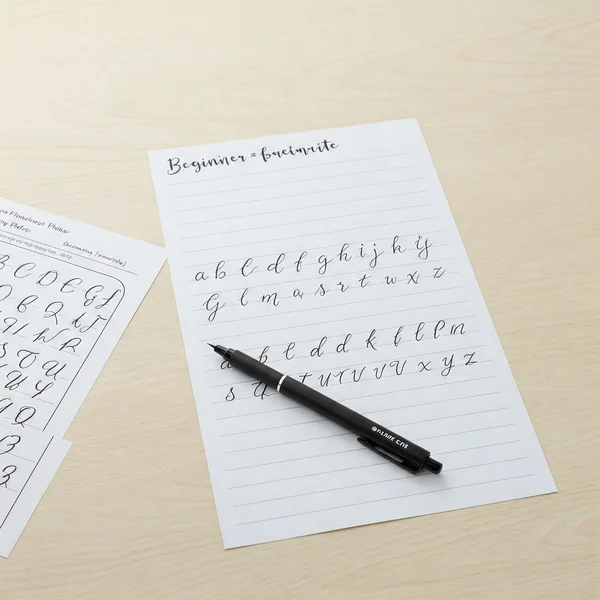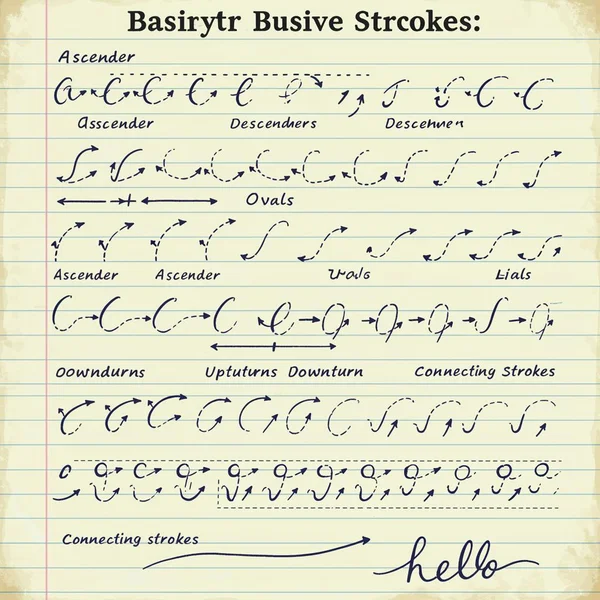Your Ultimate Beginner's Guide to Learning the Cursive Alphabet
Have you ever admired the elegance of flowing, connected script and wished you could write like that? Learning the cursive alphabet is a rewarding skill that adds a personal touch to your writing, enhances cognitive skills, and connects you to a timeless tradition. But perhaps you're wondering, Why learn cursive in today's digital age? This guide is designed specifically for cursive for beginners, providing everything you need to embark on your cursive handwriting journey with confidence. Ready to unlock this beautiful form of penmanship? Explore the comprehensive cursive resources available right here to begin your journey today.
Why Embark on the Cursive Writing Journey?
Learning cursive offers more than just aesthetic appeal. It's a valuable skill with surprising benefits.
The Enduring Charm of Handwritten Script
In an era dominated by keyboards, handwritten script writing stands out. Cursive adds personality and warmth to cards, letters, and even everyday notes, making your communication more unique and memorable. It’s a way to express yourself beyond just the words you choose.
Benefits of Learning Cursive Today
Studies suggest that the process of learning and writing cursive can improve fine motor skills, hand-eye coordination, and even cognitive functions like memory recall. The connected nature of cursive letters encourages fluid thinking and can be a relaxing, mindful activity, fostering creativity. Understanding the benefits of cursive can be a great motivator.
What This Beginner's Guide Will Cover
This guide will walk you through the absolute cursive writing basics. We'll cover the essential cursive tools, fundamental strokes, how to start cursive with simple cursive letters, and effective cursive practice tips. By the end, you'll have a clear roadmap to start mastering the alphabet in cursive.
Essential Tools for Cursive Beginners
What do I need to start cursive? Luckily, you don't need much, but choosing the right tools can make the learning process smoother.
Choosing the Right Pen: Smooth Ink Flow Matters
While any pen can work, a pen with smooth, consistent ink flow makes forming connected letters much easier. Gel pens or rollerball pens are often great choices for beginners. Avoid pens that skip or require excessive pressure. As you progress, you might explore fountain pens for a more traditional feel.
Paper Considerations: Lined vs. Blank
Start with lined paper designed for handwriting practice. The baseline, midline, and ascender/descender lines provide crucial guides for consistent letter height and slant. You can find specialized cursive practice paper, but standard wide-ruled notebook paper works well too.
Finding Quality Practice Sheets
Practice sheets are invaluable. Look for sheets that introduce letters progressively and offer tracing opportunities. High-quality printable cursive worksheets break down letter formation step-by-step, making the learning process much less daunting. You'll find a great selection to get you started right here.

Understanding Basic Cursive Strokes
Before tackling full letters, familiarize yourself with the foundational movements – the basic cursive strokes that form the building blocks of the entire cursive alphabet.
Upstrokes, Downstrokes, and Ovals
Most cursive letters are combinations of a few simple strokes: gentle upward curves (upstrokes), straight or slightly curved downward lines (downstrokes), and rounded shapes (ovals). Practicing these basic shapes helps develop muscle memory and control.
Mastering Loops
Many cursive letters have loops that extend above the midline (ascenders, like in 'l' or 'h') or below the baseline (descenders, like in 'g' or 'y'). Getting the size and shape of these loops consistent is key to legible cursive handwriting.
Connecting the Dots
The magic of cursive lies in its connections. Each letter typically starts with an 'entry' stroke and ends with an 'exit' stroke, designed to flow smoothly into the next letter. Understanding these connection points is crucial for fluid script writing.

Your First Steps with Easy Letters
How to start cursive writing? Don't try to learn the entire alphabet at once! Start simple.
Lowercase First: Why It's Often Recommended
Most experts recommend starting with lowercase letters. They form the bulk of written text and often share more common basic cursive strokes, making them a logical starting point for cursive for beginners.
Simple Letters to Begin With
Focus initially on letters formed with basic upstrokes, downstrokes, and simple curves. Letters like 'i', 't', 'u', 'w', 'l', and 'e' are often considered part of an easy cursive alphabet group to start with because their shapes are relatively straightforward and introduce fundamental movements.
A Glimpse into Uppercase vs. Lowercase Differences
Uppercase cursive letters often have different, sometimes more elaborate, forms than their lowercase counterparts. We'll cover those in detail later, but for now, concentrate on mastering the lowercase alphabet in cursive. You can always refer to a complete cursive alphabet chart to see them all.
Effective Tips to Learn Cursive Alphabet Quickly
Learning cursive takes time and patience, but these tips can help you improve cursive skills effectively.
Short, Regular Practice Sessions
Aim for short, focused cursive practice sessions (10-15 minutes) daily or several times a week, rather than one long, infrequent session. Consistency builds muscle memory much faster.
Focus on Form, Not Speed
Resist the urge to write quickly at the beginning. Concentrate on forming each letter correctly, paying attention to slant, size, spacing, and connections. Speed will come naturally with practice and confidence.
Trace, Copy, Then Write from Memory
Use a three-step approach: First, trace over well-formed examples on a worksheet. Next, copy the letter directly beside the example. Finally, try writing the letter from memory. This progression reinforces learning.
Utilize Printable Worksheets Effectively
Worksheets are your best friend! They provide structured practice and visual guides. Don't just passively trace; actively think about the strokes as you form them. Need effective practice materials? Find helpful resources, including printable cursive worksheets, right here.

Be Patient and Celebrate Small Wins
Learning any new skill takes time. Don't get discouraged by imperfections. Acknowledge your progress, even small improvements like a perfectly formed loop or a smooth connection. Enjoy the process of learning this elegant penmanship style.
Ready to Write? Your Next Steps in Mastering Cursive
You've now got the foundational knowledge and tools to start your cursive journey!
Recap: Your Cursive Starting Toolkit
Remember the key steps: gather your basic cursive tools (pen and lined paper), understand the basic cursive strokes, start with simple cursive letters (lowercase first!), and practice consistently using effective techniques.
Embrace the Process and Keep Practicing
Learning the cursive alphabet is a marathon, not a sprint. Be patient with yourself, enjoy the mindful process of forming letters, and watch your cursive handwriting gradually transform.
Explore Our Letter Guides and Download Free Worksheets
Ready to dive deeper and tackle specific letters? Explore our individual letter guides or download your first set of free practice sheets to put these tips into action! Get everything you need to succeed with our comprehensive cursive guides and worksheets.
What are your cursive learning goals? Are you learning for fun, for school, or for creative projects? Share your aspirations in the comments below – we'd love to hear from you!
Frequently Asked Questions for Cursive Beginners
Here are answers to some common questions from those starting out:
Is cursive difficult for beginners to learn?
Like any new motor skill, cursive requires practice and patience. It might seem challenging initially, but it's definitely achievable! Breaking it down into basic strokes and simple letters, as outlined in this beginner cursive guide, makes it much more manageable. Using structured resources certainly helps ease the learning curve.
How long does it typically take to learn basic cursive?
The timeframe varies greatly depending on the individual and the amount of consistent practice. Some might grasp the basics in a few weeks with daily practice, while others might take a few months to feel comfortable. Consistent practice using resources like these cursive practice materials can significantly speed up the process. Focus on progress, not a deadline.
What is considered the easiest cursive alphabet style to start with?
Simpler, less ornate styles (sometimes called "basic" or "modern" cursive) are generally considered easier for beginners than highly elaborate styles like Spencerian. These simpler styles focus on clear letter formation and connection without excessive flourishes, making them a great starting point. Our resources focus on a clear, accessible style perfect for learning.
Do I need special pens to learn cursive?
No, you don't need special pens. A smooth-writing ballpoint, gel, or rollerball pen works perfectly well for beginners. The key is consistent ink flow, not the type of pen itself.
Where can I find a complete cursive alphabet chart?
A reliable cursive alphabet chart showing both uppercase and lowercase letters is essential! You can find a clear and helpful cursive alphabet chart showcasing the standard forms directly on our main page for easy reference.